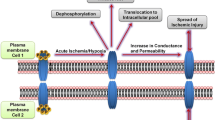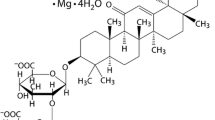Abstract
Unapposed connexin 43 hemichannels (Cx43Hc) are present on sarcolemma of cardiomyocytes. Whereas Cx43Hc remain closed during physiological conditions, their opening under ischemic stress contributes to irreversible tissue injury and cell death. To date, conventional blockers of connexin channels act unselectively on both gap junction channels and unapposed hemichannels. Here, we test the hypothesis that Gap26, a synthetic structural mimetic peptide deriving from the first extracellular loop of Cx43 and a presumed selective blocker of Cx43Hc, confers resistance to intact rat heart against ischemia injury. Langendorff-perfused intact rat hearts were utilized. Regional ischemia was induced by 40-min occlusion of the left anterior descendent coronary and followed by 180 min of reperfusion. Gap26 was applied either 10 min before or 30 min after the initiation of ischemia. Interestingly, myocardial infarct size was reduced by 48% and 55% in hearts treated with Gap26 before or during ischemia, respectively, compared to untreated hearts. Additionally, myocardial perfusate flow was increased in both groups during reperfusion by 37% and 32%, respectively. Application of Gap26 increased survival of isolated cardiomyocytes after simulated ischemia–reperfusion by nearly twofold compared to untreated cells. On the other hand, superfusion of tsA201 cells transiently expressing Cx43 with Gap26 caused 61% inhibition of Cx43Hc-mediated currents recorded using the patch clamp technique. In summary, we demonstrate for the first time that Cx43 mimetic peptide Gap26 confers protection to intact heart against ischemia–reperfusion injury whether administered before or after the occurrence of ischemia. In addition, we provide unequivocal evidence for the inhibitory effect of Gap26 on genuine Cx43Hc.






Similar content being viewed by others
References
Armstrong S, Downey JM, Ganote CE (1994) Preconditioning of isolated rabbit cardiomyocytes: induction by metabolic stress and blockade by the adenosine antagonist SPT and calphostin C, a protein kinase C inhibitor. Cardiovasc Res 28:72–77
Armstrong SC, Kao R, Gao W, Shivell LC, Downey JM, Honkanen RE, Ganote CE (1997) Comparison of in vitro preconditioning responses of isolated pig and rabbit cardiomyocytes: effects of a protein phosphatase inhibitor, fostriecin. J Mol Cell Cardiol 29:3009–3024
Bendukidze Z, Isenberg G, Klockner U (1985) Ca-tolerant guinea-pig ventricular myocytes as isolated by pronase in the presence of 250 microM free calcium. Basic Res Cardiol 80(Suppl 1):13–17
Bennett MV, Contreras JE, Bukauskas FF, Saez JC (2003) New roles for astrocytes: gap junction hemichannels have something to communicate. Trends Neurosci 26:610–617
Braet K, Aspeslagh S, Vandamme W, Willecke K, Martin PE, Evans WH, Leybaert L (2003) Pharmacological sensitivity of ATP release triggered by photoliberation of inositol-1, 4, 5-trisphosphate and zero extracellular calcium in brain endothelial cells. J Cell Physiol 197:205–213
Braet K, Vandamme W, Martin PE, Evans WH, Leybaert L (2003) Photoliberating inositol-1, 4, 5-trisphosphate triggers ATP release that is blocked by the connexin mimetic peptide gap 26. Cell Calcium 33:37–48
Chaytor AT, Evans WH, Griffith TM (1997) Peptides homologous to extracellular loop motifs of connexin 43 reversibly abolish rhythmic contractile activity in rabbit arteries. J Physiol 503(Pt 1):99–110
Chaytor AT, Evans WH, Griffith TM (1998) Central role of heterocellular gap junctional communication in endothelium-dependent relaxations of rabbit arteries. J Physiol 508(Pt 2):561–573
Chen L, Hahn H, Wu G, Chen CH, Liron T, Schechtman D, Cavallaro G, Banci L, Guo Y, Bolli R, Dorn GW, Mochly-Rosen D (2001) Opposing cardioprotective actions and parallel hypertrophic effects of delta PKC and epsilon PKC. Proc Natl Acad Sci U S A 98:11114–11119
Chen L, Wright LR, Chen CH, Oliver SF, Wender PA, Mochly-Rosen D (2001) Molecular transporters for peptides: delivery of a cardioprotective epsilonPKC agonist peptide into cells and intact ischemic heart using a transport system, R(7). Chem Biol 8:1123–1129
Clarke TC, Williams OJ, Martin PE, Evans WH (2009) ATP release by cardiac myocytes in a simulated ischaemia model: inhibition by a connexin mimetic and enhancement by an antiarrhythmic peptide. Eur J Pharmacol 605:9–14
Cohen MV, Liu GS, Downey JM (1991) Preconditioning causes improved wall motion as well as smaller infarcts after transientcoronary occlusion in rabbits. Circulation 84:341–349
Contreras JE, Saez JC, Bukauskas FF, Bennett MV (2003) Gating and regulation of connexin 43 (Cx43) hemichannels. Proc Natl Acad Sci U S A 100:11388–11393
Contreras JE, Sanchez HA, Eugenin EA, Speidel D, Theis M, Willecke K, Bukauskas FF, Bennett MV, Saez JC (2002) Metabolic inhibition induces opening of unapposed connexin 43 gap junction hemichannels and reduces gap junctional communication in cortical astrocytes in culture. Proc Natl Acad Sci U S A 99:495–500
Dahl G (2007) Gap junction-mimetic peptides do work, but in unexpected ways. Cell Commun Adhes 14:259–264
Dahl G (1996) Where are the gates in gap junction channels? Clin Exp Pharmacol Physiol 23:1047–1052
Evans WH, Boitano S (2001) Connexin mimetic peptides: specific inhibitors of gap-junctional intercellular communication. Biochem Soc Trans 29:606–612
Evans WH, De Vuyst E, Leybaert L (2006) The gap junction cellular internet: connexin hemichannels enter the signalling limelight. Biochem J 397:1–14
Gomes P, Srinivas SP, Van Driessche W, Vereecke J, Himpens B (2005) ATP release through connexin hemichannels in corneal endothelial cells. Invest Ophthalmol Vis Sci 46:1208–1218
Goodenough DA, Paul DL (2003) Beyond the gap: functions of unpaired connexon channels. Nat Rev Mol Cell Biol 4:285–294
Gottlieb RA, Burleson KO, Kloner RA, Babior BM, Engler RL (1994) Reperfusion injury induces apoptosis in rabbit cardiomyocytes. J Clin Invest 94:1621–1628
Gray MO, Karliner JS, Mochly-Rosen D (1997) A selective epsilon-protein kinase C antagonist inhibits protection of cardiac myocytes from hypoxia-induced cell death. J Biol Chem 272:30945–30951
Hatanaka K, Kawata H, Toyofuku T, Yoshida K (2004) Down-regulation of connexin43 in early myocardial ischemia and protective effect by ischemic preconditioning in rat hearts in vivo. Jpn Heart J 45:1007–1019
Hawat G, Baroudi G (2008) Differential modulation of unapposed connexin 43 hemichannel electrical conductance by protein kinase C isoforms. Pflugers Arch 456:519–527
Hund TJ, Lerner DL, Yamada KA, Schuessler RB, Saffitz JE (2007) Protein kinase C epsilon mediates salutary effects on electrical coupling induced by ischemic preconditioning. Heart Rhythm 4:1183–1193
Inagaki K, Hahn HS, Dorn GW, Mochly-Rosen D (2003) Additive protection of the ischemic heart ex vivo by combined treatment with delta-protein kinase C inhibitor and epsilon-protein kinase C activator. Circulation 108:869–875
Jennings RB, Reimer KA, Steenbergen C (1986) Myocardial ischemia revisited. The osmolar load, membrane damage, and reperfusion. J Mol Cell Cardiol 18:769–780
John SA, Kondo R, Wang SY, Goldhaber JI, Weiss JN (1999) Connexin-43 hemichannels opened by metabolic inhibition. J Biol Chem 274:236–240
Kondo RP, Wang SY, John SA, Weiss JN, Goldhaber JI (2000) Metabolic inhibition activates a non-selective current through connexin hemichannels in isolated ventricular myocytes. J Mol Cell Cardiol 32:1859–1872
Kwak BR, Jongsma HJ (1999) Selective inhibition of gap junction channel activity by synthetic peptides. J Physiol 516(Pt 3):679–685
Leybaert L, Braet K, Vandamme W, Cabooter L, Martin PE, Evans WH (2003) Connexin channels, connexin mimetic peptides and ATP release. Cell Commun Adhes 10:251–257
Li F, Sugishita K, Su Z, Ueda I, Barry WH (2001) Activation of connexin-43 hemichannels can elevate [Ca(2+)]i and [Na(+)]i in rabbit ventricular myocytes during metabolic inhibition. J Mol Cell Cardiol 33:2145–2155
Li X, Heinzel FR, Boengler K, Schulz R, Heusch G (2004) Role of connexin 43 in ischemic preconditioning does not involve intercellular communication through gap junctions. J Mol Cell Cardiol 36:161–163
Liu GS, Cohen MV, Mochly-Rosen D, Downey JM (1999) Protein kinase C-epsilon is responsible for the protection of preconditioning in rabbit cardiomyocytes. J Mol Cell Cardiol 31:1937–1948
Margolskee RF, Hendry-Rinde B, Horn R (1993) Panning transfected cells for electrophysiological studies. Biotechniques 15:906–911
Miura T, Ohnuma Y, Kuno A, Tanno M, Ichikawa Y, Nakamura Y, Yano T, Miki T, Sakamoto J, Shimamoto K (2004) Protective role of gap junctions in preconditioning against myocardial infarction. Am J Physiol Heart Circ Physiol 286:H214–H221
Mosmann T (1983) Rapid colorimetric assay for cellular growth and survival: application to proliferation and cytotoxicity assays. J Immunol Meth 65:55–63
Murry CE, Jennings RB, Reimer KA (1986) Preconditioning with ischemia: a delay of lethal cell injury in ischemic myocardium. Circulation 74:1124–1136
Padilla F, Garcia-Dorado D, Rodriguez-Sinovas A, Ruiz-Meana M, Inserte J, Soler-Soler J (2003) Protection afforded by ischemic preconditioning is not mediated by effects on cell-to-cell electrical coupling during myocardial ischemia–reperfusion. Am J Physiol Heart Circ Physiol 285:H1909–H1916
Pearson RA, Dale N, Llaudet E, Mobbs P (2005) ATP released via gap junction hemichannels from the pigment epithelium regulates neural retinal progenitor proliferation. Neuron 46:731–744
Ping P, Zhang J, Qiu Y, Tang XL, Manchikalapudi S, Cao X, Bolli R (1997) Ischemic preconditioning induces selective translocation of protein kinase C isoforms epsilon and eta in the heart of conscious rabbits without subcellular redistribution of total protein kinase C activity. Circ Res 81:404–414
Quist AP, Rhee SK, Lin H, Lal R (2000) Physiological role of gap-junctional hemichannels. Extracellular calcium-dependent isosmotic volume regulation. J Cell Biol 148:1063–1074
Romanov RA, Rogachevskaja OA, Bystrova MF, Jiang P, Margolskee RF, Kolesnikov SS (2007) Afferent neurotransmission mediated by hemichannels in mammalian taste cells. EMBO J 26:657–667
Saez JC, Retamal MA, Basilio D, Bukauskas FF, Bennett MV (2005) Connexin-based gap junction hemichannels: gating mechanisms. Biochim Biophys Acta 1711:215–224
Saurin AT, Pennington DJ, Raat NJ, Latchman DS, Owen MJ, Marber MS (2002) Targeted disruption of the protein kinase C epsilon gene abolishes the infarct size reduction that follows ischaemic preconditioning of isolated buffer-perfused mouse hearts. Cardiovasc Res 55:672–680
Scemes E, Spray DC, Meda P (2009) Connexins, pannexins, innexins: novel roles of “hemi-channels”. Pflugers Arch 457:1207–1226
Schulz R, Gres P, Skyschally A, Duschin A, Belosjorow S, Konietzka I, Heusch G (2003) Ischemic preconditioning preserves connexin 43 phosphorylation during sustained ischemia in pig hearts in vivo. FASEB J 17:1355–1357
Shiki K, Hearse DJ (1987) Preconditioning of ischemic myocardium: reperfusioninduced arrhythmias. Am J Physiol 253:H1470–H1476
Shintani-Ishida K, Uemura K, Yoshida K (2007) Hemichannels in cardiomyocytes open transiently during ischemia and contribute to reperfusion injury following brief ischemia. Am J Physiol Heart Circ Physiol 293:H1714–H1720
Steenbergen C, Hill ML, Jennings RB (1985) Volume regulation and plasma membrane injury in aerobic, anaerobic, and ischemic myocardium in vitro. Effects of osmotic cell swelling on plasma membrane integrity. Circ Res 57:864–875
Tranum-Jensen J, Janse MJ, Fiolet WT, Krieger WJ, D'Alnoncourt CN, Durrer D (1981) Tissue osmolality, cell swelling, and reperfusion in acute regional myocardial ischemia in the isolated porcine heart. Circ Res 49:364–381
Vergara L, Bao X, Cooper M, Bello-Reuss E, Reuss L (2003) Gap-junctional hemichannels are activated by ATP depletion in human renal proximal tubule cells. J Membr Biol 196:173–184
Verma V, Hallett MB, Leybaert L, Martin PE, Evans WH (2009) Perturbing plasma membrane hemichannels attenuates calcium signalling in cardiac cells and HeLa cells expressing connexins. Eur J Cell Biol 88:79–90
Verselis VK, Trexler EB, Bukauskas FF (2000) Connexin hemichannels and cell–cell channels: comparison of properties. Braz J Med Biol Res 33:379–389
Wang J, Ma M, Locovei S, Keane RW, Dahl G (2007) Modulation of membrane channel currents by gap junction protein mimetic peptides: size matters. Am J Physiol Cell Physiol 293:C1112–C1119
Wilde AA, Aksnes G (1995) Myocardial potassium loss and cell depolarisation in ischaemia and hypoxia. Cardiovasc Res 29:1–15
Winer BJ (1971) Statistical principles in experimental design, 2nd edn. McGraw-Hill, New York
Zhao ZQ, Nakamura M, Wang NP, Wilcox JN, Shearer S, Ronson RS, Guyton RA, Vinten-Johansen J (2000) Reperfusion induces myocardial apoptotic cell death. Cardiovasc Res 45:651–660
Acknowledgments
The authors thank Michel Vermeulen and Sophie Binette for their technical help and assistance.
Funding
This work was supported by grants from Heart and Stroke Foundation of Québec [G-07-BA-2924], the Fonds de Recherche en Santé du Québec [13836], and the Natural Science and Engineering Research Council [341794-07]. Dr. G. Baroudi is a research scholar of the FRSQ.
Conflict of interest
None declared.
Author information
Authors and Affiliations
Corresponding author
Rights and permissions
About this article
Cite this article
Hawat, G., Benderdour, M., Rousseau, G. et al. Connexin 43 mimetic peptide Gap26 confers protection to intact heart against myocardial ischemia injury. Pflugers Arch - Eur J Physiol 460, 583–592 (2010). https://doi.org/10.1007/s00424-010-0849-6
Received:
Revised:
Accepted:
Published:
Issue Date:
DOI: https://doi.org/10.1007/s00424-010-0849-6




